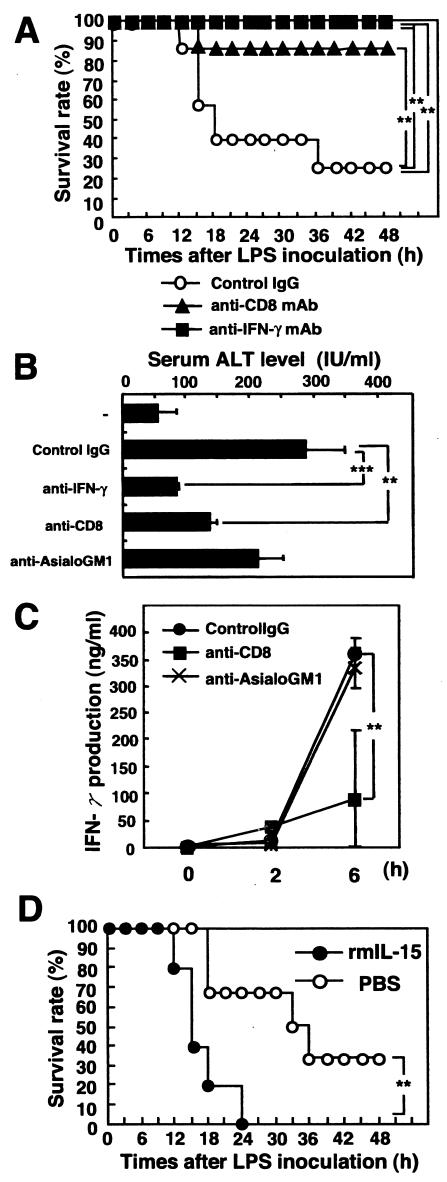FIG. 5.
IFN-γ production by T cells in BCG-primed C57BL/6 mice is responsible for LPS-induced lethal endotoxin shock. (A) Effect of neutralization of endogenous IFN-γ or depletion of CD8+ T cells on susceptibility to LPS-induced liver injury and lethal shock in BCG-primed mice. C57BL/6 mice were primed with an i.v. injection of M. bovis BCG (1 mg ≈ 106 CFU) via tail veins and were challenged 7 days later with an i.v. injection of LPS (10 μg). Mice were treated i.p. with neutralizing anti-IFN-γ MAb (R4 6A2), anti-CD8 MAb (2.43), or control rat IgG at 2 h before and 2 h after LPS injection. The survival of mice was checked every hour. **, significantly different from the value for control mice (P value of <0.01 by the generalized Wilcoxon test). (B) Effect of depletion of CD8 or NK cells on LPS-induced liver injury in BCG-primed C57BL/6 mice. C57BL/6 mice that had been infected with BCG 7 days previously were treated i.p. with anti-CD8, anti-asialo GM1 Ab, or isotype control IgG 24 h before LPS injection. Sera were collected at 6 h after LPS challenge from Ab-treated mice. ALT levels in serum after LPS challenge in the BCG-primed mice areshown. Data are presented as means + SDs for five mice. **, P < 0.01; ***, P < 0.001. (C) Effect of depletion of CD8+ T or NK cells on IFN-γ production in BCG-infected mice. C57BL/6 mice were treated i.p. with anti-CD8 MAb, anti-asialo GM1 Ab, or control IgG 24 h before LPS injection. Sera were collected at 2 and 6 h after LPS challenge from Ab-treated mice. IFN-γ levels in serum after LPS challenge in BCG-primed mice are shown. Data are presented as the means + SDs for five mice. **, P < 0.01. (D) Effects of in vivo administration of rIL-15 on LPS-induced lethal shock in C57BL/6 mice infected with BCG. rIL-15 (2 μg in 200 μl of PBS) or PBS (200 μl) for control was injected i.p. at 2 h before and 2 h after LPS injection, and survival was monitored for 48 h. Seven to 10 mice per group were used per experiment. The typical results of one of three independent experiments are shown. **, significantly different from the value for control mice (P value of <0.01 by the generalized Wilcoxon test).

